Opening this Month
| |
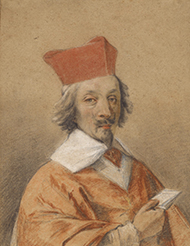 Portrait of Armand-Jean du Plessis, Cardinal de Richelieu (detail), about 1632–1634, Simon Vouet. Black, white, and red chalk with pink fabricated chalk. The J. Paul Getty Museum
Portrait of Armand-Jean du Plessis, Cardinal de Richelieu (detail), about 1632–1634, Simon Vouet. Black, white, and red chalk with pink fabricated chalk. The J. Paul Getty Museum
|
The Birth of Pastel
June 6–December 17, 2017 | The Getty Center
Featuring works by Jacopo Bassano, Federico Barocci, Simon Vouet, Robert Nanteuil, Joseph Vivien, Rosalba Carriera, and Maurice-Quentin de La Tour, the installation focuses most closely on the late seventeenth and early eighteenth century, when pastels began to rival oils—in their variety of color, their high degree of finish, and even their scale—as the preferred medium for stately portraits.
Learn more about the exhibition »
| |
 Lion Attacking an Onager (detail), A.D. 150–200, Hadrumetum, (now Tunisia), stone and glass. The J. Paul Getty Museum
Lion Attacking an Onager (detail), A.D. 150–200, Hadrumetum, (now Tunisia), stone and glass. The J. Paul Getty Museum
|
Roman Mosaics across the Empire
June 9, 2017–January 8, 2018
| The Getty Villa
Roman decor was unique for the elaborate mosaic floors that transformed entire rooms into spectacular settings of vibrant color, figural imagery, and geometric design. Scenes from mythology, daily life, the natural world, and spectacles in the arena enlivened interior spaces and reflected the cultural ambitions of wealthy patrons. This exhibition presents the artistry of mosaics, as well as the contexts of their discovery across Rome's expanding empire—from its center in Italy to provinces in North Africa, southern Gaul, and ancient Syria.
Learn more about the exhibition »
| |
 Saint Anne Teaching the Virgin to Read (detail), about 1430–1440, Master of Sir John Fastolf. Tempera colors, gold leaf, and ink on parchment. The J. Paul Getty Museum
Saint Anne Teaching the Virgin to Read (detail), about 1430–1440, Master of Sir John Fastolf. Tempera colors, gold leaf, and ink on parchment. The J. Paul Getty Museum
|
Illuminating Women in the Medieval World
June 20–September 17, 2017 | The Getty Center
From damsels in distress to powerful patrons, from the Virgin Mary to the adulterous Bathsheba, a wide variety of female figures populated the pages of medieval manuscripts. Virtuous women such as biblical heroines, steadfast saints, and pious nuns were held up as models for proper behavior, while lascivious women were warnings against sinful conduct. Female figures fulfilled the romantic role of lovers, the social and political function of wives, and the nurturing capacity of mothers. They were also creators of manuscripts; women of great wealth and high status exercised their authority and influence by commissioning books—and sometimes even illuminating them.
| |
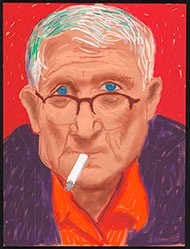 Self Portrait, 20 March 2012 (1219), 2012, David Hockney. iPad drawing printed on paper. 32 x 24 in. Courtesy of the artist. © David Hockney
Self Portrait, 20 March 2012 (1219), 2012, David Hockney. iPad drawing printed on paper. 32 x 24 in. Courtesy of the artist. © David Hockney
|
Happy Birthday, Mr. Hockney
June 27–November 26, 2017 | The Getty Center
In celebration of David Hockney's eightieth birthday and his long and continuing artistic career, the Getty Museum presents a two-part exhibition featuring the artist’s highly creative self-portraits and photographs.
Self-Portraits, opening on June 27, features a selection of drawn, painted, and photographic self-portraits made over the past sixty-five years, from the 1950s when he was a teenage art student through to a selection of iPad studies made in 2012.
Opening on July 18, Photographs displays a number of composite Polaroids and photo collages that mark Hockney's photographic explorations of the 1980s.
Continuing This Month
| |
 The Musical Performance in the Teatro Argentina in Honor of the Marriage of the Dauphin, 1747, Giovanni Paolo Panini. Oil on canvas. Musée du Louvre, Departement des Peintures. Image © RMN-Grand Palais / Art Resource, NY
The Musical Performance in the Teatro Argentina in Honor of the Marriage of the Dauphin, 1747, Giovanni Paolo Panini. Oil on canvas. Musée du Louvre, Departement des Peintures. Image © RMN-Grand Palais / Art Resource, NY
|
Eyewitness Views: Making History in Eighteenth-Century Europe
Through July 30, 2017 | The Getty Center
From Paris to Venice to Rome, Europe's most iconic cities and monuments have played host to magnificent ceremonies. During the eighteenth century, princes, popes, and ambassadors commissioned master painters such as Canaletto and Panini to record memorable moments, from the Venetian carnival to eruptions of Vesuvius, inspiring what became the golden age of view paintings. This first-ever exhibition focusing on views of historic events turns the beholder into an eyewitness on the scene.
Learn more about the exhibition »
| |
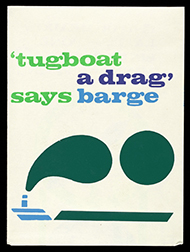 Poem from Headlines, Pondlines, Ian Hamilton Finlay (Scottish, 1925–2006), 1969. John Furnival (British, b. 1933), draftsman, and Frankie Partridge (British), artist. The Getty Research Institute, 890164. By Courtesy of the Estate of Ian Hamilton Finlay
Poem from Headlines, Pondlines, Ian Hamilton Finlay (Scottish, 1925–2006), 1969. John Furnival (British, b. 1933), draftsman, and Frankie Partridge (British), artist. The Getty Research Institute, 890164. By Courtesy of the Estate of Ian Hamilton Finlay
|
Concrete Poetry: Words and Sounds in Graphic Space
Through July 30, 2017 | The Getty Center
Drawn principally from the Getty Research Institute's collection of prints, artists' books, journals, and manuscripts documenting the international concrete poetry movement, this exhibition focuses on the visual, verbal, and sonic experiments of the 1950s, '60s, and '70s.
Concrete Poetry features works by foundational figures Augusto de Campos and Ian Hamilton Finlay and by their contemporaries, including Henri Chopin, Ernst Jandl, Mary Ellen Solt, and Emmett Williams.
Learn more about the exhibition »
| |
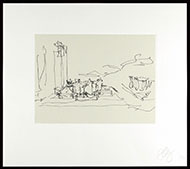 Frank Gehry (Canadian-born American, b. 1929). Perspective sketch of Disney Hall, The Walt Disney Concert Hall Portfolio, 2003. Los Angeles, Getty Research Institute, 2009.PR.3
Frank Gehry (Canadian-born American, b. 1929). Perspective sketch of Disney Hall, The Walt Disney Concert Hall Portfolio, 2003. Los Angeles, Getty Research Institute, 2009.PR.3
|
Berlin/Los Angeles: Space for Music
Through July 30, 2017 | The Getty Center
This exhibition celebrates the 50th anniversary of the sister-city partnership between Berlin and Los Angeles by exploring two iconic buildings: Hans Scharoun's Berlin Philharmonic (Berliner Philharmonie, built 1960–1963) and Frank Gehry's Walt Disney Concert Hall (built 1999–2003). Focusing on the buildings' extraordinary interiors and exteriors,
Berlin/Los Angeles: Space for Music brings together original drawings, sketches, prints, photographs, and models to convey the architects' design processes.
Learn more about the exhibition »
Browse all current exhibitions »
Extended Summer Hours
Beginning May 26, make the most of your summer days with
extended weekend hours at the Getty!
Getty Center Extended Hours
Friday and Saturday: 10:00 a.m.–9:00 p.m.
Getty Villa Extended Hours
Saturday: 10:00 a.m.–9:00 p.m.
PERFORMANCES
| |
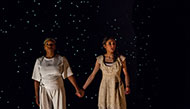 Photo: Kelly Stuart
Photo: Kelly Stuart
|
Villa Play Reading: The Laodamiad
Saturday and Sunday, June 3 and 4, 3:00 p.m.
| The Getty Villa
When the Trojan War begins, Laodamia does everything to keep her husband safe at home, but fate and politics conspire to put him at the invasion's frontline. Inspired by the surviving lines of Euripides's lost play
Protesilaos,
The Laodamiad explores grief through the eyes of literature's first war widow. This program is a staged reading with music.
Get tickets »
| |
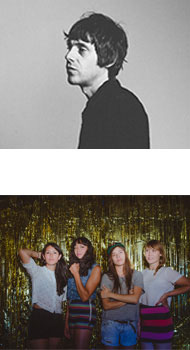 Top: White Fence
Top: White Fence
Bottom: La Luz
|
Off the 405
June 10 and 24, 6:00–9:00 p.m. | The Getty Center
White Fence
Saturday, June 10
The jangly, modish cool of The Kinks collide with flowery San Francisco bohemia in White Fence, the central project of the multi-faceted musician Tim Presley.
Learn More»
La Luz
Saturday, June 24
Led by frontwoman Shana Cleveland, La Luz combines bright, snappy surf music, retro girl-group harmonies, and indie rock into one smart package.
Learn More»
Friday Flights
Friday, June 16, 6:00–9:00 p.m. | The Getty Center
Friday Flights is a series of interdisciplinary happenings that brings together a range of artists to transform the Getty experience. Visual artist Brendan Fernandes and musician How To Dress Well present
Free Fall 49, a tribute to the victims of the 2016 mass shooting at Orlando's Pulse nightclub, instrumental guitarists William Tyler and Noveller collaborate on a special performance, and musician Sam Rowell creates a light and sound installation in the Central Garden.
Learn More»
TALKS
| |
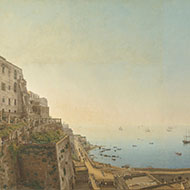 A View of the Bay of Naples, Looking Southwest from the Pizzofalcone towards Capo di Posilippo (detail), 1791, Giovanni Battista Lusieri. Watercolor, gouache, graphite, and pen and ink on six sheets of paper. The J. Paul Getty Museum
A View of the Bay of Naples, Looking Southwest from the Pizzofalcone towards Capo di Posilippo (detail), 1791, Giovanni Battista Lusieri. Watercolor, gouache, graphite, and pen and ink on six sheets of paper. The J. Paul Getty Museum
|
The Bumpy Road to Beautiful Italy
Sunday, June 4, 3:00 p.m. | The Getty Center
With one eye on the practicalities and perils of travel in Italy in past centuries, Julian Brooks, senior curator of drawings at the Getty, discusses some of the works of art made by visitors to the country, and how they responded to—and fueled—the lure of Italy.
Get tickets »
| |
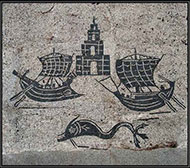 Mosaic pavement discovered in Ostia, the harbor city of ancient Rome, where staple and luxury goods flowed into the empire from Egypt, Sicily, Africa, Arabia, India and beyond. Stall 46, Piazzale delle Corporazioni (regio II, insula VII, 4), Ostia Antica, Italy.
Mosaic pavement discovered in Ostia, the harbor city of ancient Rome, where staple and luxury goods flowed into the empire from Egypt, Sicily, Africa, Arabia, India and beyond. Stall 46, Piazzale delle Corporazioni (regio II, insula VII, 4), Ostia Antica, Italy.
|
What Can the Ancient World Teach Us About Globalization?
Wednesday, June 7, 7:30 p.m.
| The Getty Villa
Today's backlash against globalization raises hard questions. What does greater connectedness across borders mean for jobs, national identities, culture, and governments? The ancient Greek and Roman worlds also saw increasing flows of objects, people, and ideas that created a broader international consciousness—and no small amount of dislocation and turmoil. This panel, presented with Zócalo Public Square, reckons with timeless questions of globalization.
Learn more and get tickets »
| |
 Uvena Novae Villiae, about 1854, Anna Atkins and Anne Dixon. Cyanotype. The J. Paul Getty Museum
Uvena Novae Villiae, about 1854, Anna Atkins and Anne Dixon. Cyanotype. The J. Paul Getty Museum
|
What Does Blue Mean?
Thursday, June 8, 7:00 p.m. | The Getty Center
Blue describes emotional states, musical and literary genres, and moral codes. And yet, historically, humans have found the color itself notably difficult to pin down. How did blue come to occupy its singular scientific and cultural significance? What relationships exist between the history of blue pigments and the wealth of meanings the term conveys today? A panel with authors Catherine McKinley and Carol Mavor, scientist Mas Subramanian, and actor/comedian/singer Garrett Morris explores the science and sentiment of the color blue.
Get tickets »
Also coming up
Getty Art Book Club: Blue Mythologies on June 10.
| |
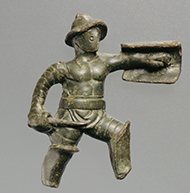 Statuette of a Gladiator, about 50 AD, Roman Empire. Bronze. The J. Paul Getty Museum, Gift of Barbara and Lawrence Fleischman. Image: Bruce White Photography
Statuette of a Gladiator, about 50 AD, Roman Empire. Bronze. The J. Paul Getty Museum, Gift of Barbara and Lawrence Fleischman. Image: Bruce White Photography
|
The Virtues of Violence: Amphitheaters, Gladiators, and the Roman System of Values
Saturday, June 17, 2:00 p.m.
| The Getty Villa
Violent spectacle—from gladiatorial combat to public executions—was a cultural symbol that the Romans exported to the furthest reaches of their empire. While modern audiences regard such shows with unmitigated revulsion, the Romans exhibited much more complex attitudes towards them. Kathleen Coleman, Harvard University, identifies some of the social and cultural preconceptions and practices connected to the displays, and discusses how intricately they were woven into the fabric of Roman society.
Learn more and get tickets »
| |
 Robert Alexander, John Reed, Wallace Berman, Juanita Dixon, and Walter Hopps in the alley next to Ferus Gallery in Los Angeles, ca. 1957. The Getty Research Institute, Charles Brittin papers, 2005.M.11.9. © J. Paul Getty Trust. Photo by Charles Brittin
Robert Alexander, John Reed, Wallace Berman, Juanita Dixon, and Walter Hopps in the alley next to Ferus Gallery in Los Angeles, ca. 1957. The Getty Research Institute, Charles Brittin papers, 2005.M.11.9. © J. Paul Getty Trust. Photo by Charles Brittin
|
Walter Hopps: The Dream Colony
Wednesday, June 28, 7:00 p.m. | The Getty Center
The Dream Colony: A Life in Art is a vivid, personal, and irreverent account of the innovative, iconoclastic curator Walter Hopps (1932–2005), begun a few years before his death. Arts writer Anne Doran, who recorded Hopps's account, and Deborah Treisman, fiction editor of
The New Yorker, who edited the autobiography, speak with Getty President James Cuno and offer an enlightening chronicle of Hopps's life and some of the greatest artistic minds of the twentieth century.
Learn more and get tickets »
From the Getty Store
Van Gogh's Vivid Colors
Challenge your imagination as you rotate the ever-changing views of this kaleidoscope inspired by one of the J. Paul Getty Museum's most popular paintings,
Irises, by Vincent van Gogh.
Shop the Collection Now>>
CONNECT WITH US
 Download the Getty360 app now—your destination for music, theater, talks, & more!
Download the Getty360 app now—your destination for music, theater, talks, & more!
Follow us, learn about what we do, and tell us about your visit!
 Portrait of Armand-Jean du Plessis, Cardinal de Richelieu (detail), about 1632–1634, Simon Vouet. Black, white, and red chalk with pink fabricated chalk. The J. Paul Getty Museum
Portrait of Armand-Jean du Plessis, Cardinal de Richelieu (detail), about 1632–1634, Simon Vouet. Black, white, and red chalk with pink fabricated chalk. The J. Paul Getty Museum Lion Attacking an Onager (detail), A.D. 150–200, Hadrumetum, (now Tunisia), stone and glass. The J. Paul Getty Museum
Lion Attacking an Onager (detail), A.D. 150–200, Hadrumetum, (now Tunisia), stone and glass. The J. Paul Getty Museum Saint Anne Teaching the Virgin to Read (detail), about 1430–1440, Master of Sir John Fastolf. Tempera colors, gold leaf, and ink on parchment. The J. Paul Getty Museum
Saint Anne Teaching the Virgin to Read (detail), about 1430–1440, Master of Sir John Fastolf. Tempera colors, gold leaf, and ink on parchment. The J. Paul Getty Museum Self Portrait, 20 March 2012 (1219), 2012, David Hockney. iPad drawing printed on paper. 32 x 24 in. Courtesy of the artist. © David Hockney
Self Portrait, 20 March 2012 (1219), 2012, David Hockney. iPad drawing printed on paper. 32 x 24 in. Courtesy of the artist. © David Hockney
















